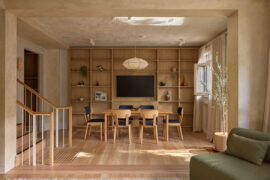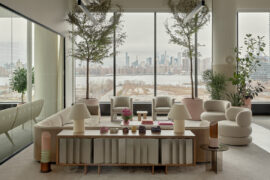The Australian Pavilion at the 2010 Venice Biennale will showcase the shortlist of the National Ideas for Australia’s cities 2050+. From 129 original submissions, 17 proposals have been chosen to be exhibited as part of the two-part ’NOW + WHEN Australian Urbanism’ exhibition, run by the Australian Institute of Architects’ 2010 Venice Architecture Biennale Creative […]
March 25th, 2010
The Australian Pavilion at the 2010 Venice Biennale will showcase the shortlist of the National Ideas for Australia’s cities 2050+.
From 129 original submissions, 17 proposals have been chosen to be exhibited as part of the two-part ’NOW + WHEN Australian Urbanism’ exhibition, run by the Australian Institute of Architects’ 2010 Venice Architecture Biennale Creative Directors, John Gollings and Ivan Rijavec.
The exhibition will highlight six of Australia’s most interesting urban and anti-urban regions as they are ‘NOW’ and will then imagine a ‘WHEN’ for 2050 and beyond.
Shortlisted ideas range from proposals of new cities set to address expected population growth by housing between 50,000-100,000 people in desert areas, through to urban development concentrated in ‘peripheral’ areas.
Sustainability was key to the future, seeing proposals for balancing bio-diversity with dense population and the conversion of major roadways into ‘landscape corridors’.
The so-called exhibition of “Urban Dreaming” will be presented in a completely new form of 3D stereoscopic technology that will change the way Australian urbanism is seen.
The exhibition will take place from 29 August until 28 November 2010. For the full list of shorlisted proposals visit the AIA website.
12th Venice Architecture Biennale
labiennale.org/en/architecture/
INDESIGN is on instagram
Follow @indesignlive
A searchable and comprehensive guide for specifying leading products and their suppliers
Keep up to date with the latest and greatest from our industry BFF's!

A longstanding partnership turns a historic city into a hub for emerging talent

London-based design duo Raw Edges have joined forces with Established & Sons and Tongue & Groove to introduce Wall to Wall – a hand-stained, “living collection” that transforms parquet flooring into a canvas of colour, pattern, and possibility.
At this exciting event, architect Paul Noritaka will deliver a speech. Bookings are not required.
The internet never sleeps! Here's the stuff you might have missed

Merging residential living with the retail experience, the latest project from In Addition breathes new life into shopping for the home.

The New York headquarters of haircare brand, Amika, has been designed by Civilian as the antithesis of a standard business hub.